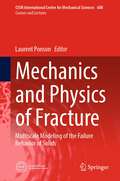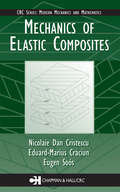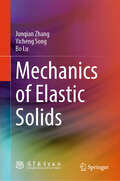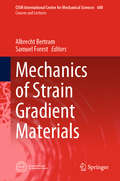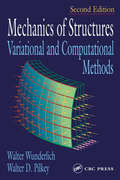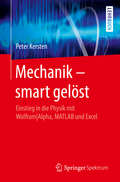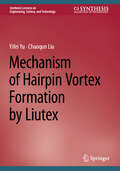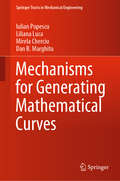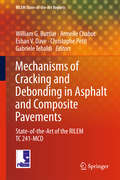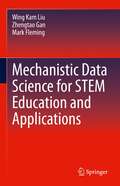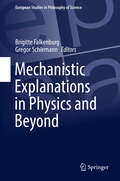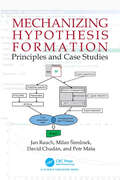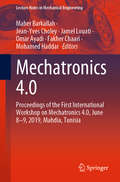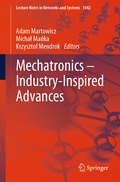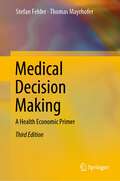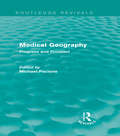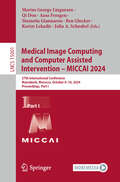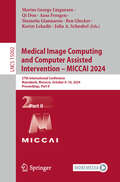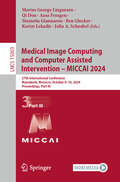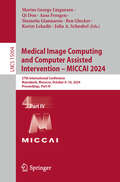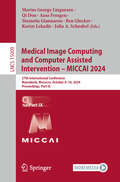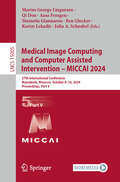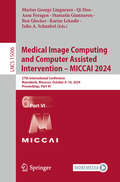- Table View
- List View
Mechanics and Physics of Fracture: Multiscale Modeling of the Failure Behavior of Solids (CISM International Centre for Mechanical Sciences #608)
by Laurent PonsonThe volume provides a comprehensive understanding of the macroscopic failure behavior of solids from the description of the microscopic failure processes and their coupling with the microstructure. Several fundamental questions were addressed: the relation between the microstructural features of materials and their fracture properties and crack trajectories; the role of damage mechanisms and non-linear deformations near the crack tip on the failure behavior of solids; and finally the role of dynamic inertial effects during fast fracture was more briefly evoked. The chapters provide a pedagogical overview of recently developed concepts and tools, that permit to perform the transition from small scales to large ones in fracture problems, thus introducing basic rules for the rational design of tough solids.
Mechanics of Elastic Composites
by Nicolaie Dan Cristescu Eduard-Marius Craciun Eugen SoósThis is a comprehensive, reader-friendly treatment of the theory behind modern elastic composite materials. The treatment includes recently developed results and methods drawn from research papers published in Eastern Europe that until now were unavailable in many western countries. Among the book's many notable features is the inclusion of more th
Mechanics of Elastic Solids
by Bo Lu Junqian Zhang Yicheng SongThis book entitled Mechanics of Elastic Solids is written as a textbook of the course “Elasticity” or “Theory of Elasticity” or “Elasticity Mechanics” for relevant engineering majors. It can also be used as a professional book for relevant technical persons. It mainly introduces elasticity theory, including stress analysis, deformation analysis, constitutive relations, elasticity model construction for actual problems, solutions for infinitesimal plane stress and strain problems, three-dimensional problems, multiphysics field problems, variation principle in elasticity, thin plate, and cylindrical shells. The rapid and continuous advancements in numerical methods and computer power have diminished the significance of certain analytical solutions in elasticity problems.. Therefore, this book simplifies some traditional contents such as the solution of plane problems and twist of cylinder. Instead, some new topics which are important for real-world problems are introduced, such as the accurate description of finite deformation, constitutive equations for small strain but large rotation problems, hyperelasticity, procedural steps and general methodologies for model construction of real-world problems, and multiphysics field problems. A plenty of examples is prepared in this book for comprehensive understanding.
Mechanics of Strain Gradient Materials (CISM International Centre for Mechanical Sciences #600)
by Samuel Forest Albrecht BertramOver the past 50 years, strain gradient material theories have been developed for the continuum modeling of size effects in materials and structures in terms of their elasticity, plasticity and fracturing. This book puts forward a unifying perspective to combine existing theories involving the higher order gradient of the strain tensor, or of plastic strain. It begins by reviewing experimental findings on the existence (or non-existence) of size effects on the mechanics of materials. In turn, the book devises first, second and higher order strain gradient theories from general principles, and presents constitutive frameworks that satisfy thermodynamic requirements. The special case of strain gradient plasticity is then developed and illustrated via computational analyses of size effects on the plasticity of metals at small scales. In closing, the book explains the origin of gradient effects in the case of lattice structures by drawing on homogenization theory.
Mechanics of Structures: Variational and Computational Methods
by Walter D. Pilkey Walter WunderlichResoundingly popular in its first edition, the second edition of Mechanics of Structures: Variational and Computational Methods promises to be even more so, with broader coverage, expanded discussions, and a streamlined presentation.The authors begin by describing the behavior of deformable solids through the differential equations for the
Mechanik – smart gelöst
by Peter KerstenDieses Buch bietet Studierenden in MINT-Fächern eine optimale Hilfestellung beim Erlernen der Grundlagen der Physik. Typische Aufgaben der Mechanik werden dabei Schritt für Schritt erklärt und mit Hilfe leistungsstarker Software aus den Bereichen Tabellenkalkulation, Computeralgebra und technisch-wissenschaftlichem Rechnen gelöst. Die dabei verwendeten Programme (Excel®, der Internetdienst Wolfram|Alpha® sowie die Software MATLAB®) sind sowohl auf Desktop-Rechnern, als auch als Apps auf mobilen Endgeräten wie Smartphones oder Tablets verfügbar – und damit immer schnell zur Hand. Das Fähigkeit mit diesen Programmen zu arbeiten kann auch im weiteren Studienverlauf und später in der beruflichen Praxis von großen Nutzen sein. Nach einer kompakten Einführung in mathematische Methoden und die verwendeten Programme deckt das Buch dabei die Bereiche der klassischen Mechanik mit den Teilgebieten Kinematik und Dynamik ab und liefert somit eine ideale Unterstützung für Einführungsvorlesungen in Physik an Hochschulen. Allen Studierenden, die sich beim Lösen von Aufgaben in der Physik schon einmal eine kleine Hilfestellung gewünscht haben, die einfach mal einen Funktionsverlauf visualisieren, eine Gleichung ohne Papier und Bleistift lösen oder das eigene Rechenergebnis überprüfen möchten, wird das vorliegende Buch ein praktischer und wertvoller Begleiter sein.
Mechanism Design: A Linear Programming Approach
by Rakesh V. VohraMechanism design is an analytical framework for thinking clearly and carefully about what exactly a given institution can achieve when the information necessary to make decisions is dispersed and privately held. This analysis provides an account of the underlying mathematics of mechanism design based on linear programming. Three advantages characterize the approach. The first is simplicity: arguments based on linear programming are both elementary and transparent. The second is unity: the machinery of linear programming provides a way to unify results from disparate areas of mechanism design. The third is reach: the technique offers the ability to solve problems that appear to be beyond solutions offered by traditional methods. No claim is made that the approach advocated should supplant traditional mathematical machinery. Rather, the approach represents an addition to the tools of the economic theorist who proposes to understand economic phenomena through the lens of mechanism design.
Mechanism of Hairpin Vortex Formation by Liutex (Synthesis Lectures on Engineering, Science, and Technology)
by Chaoqun Liu Yifei YuThis book presents the importance of the mechanism of hairpin vortex formation to understanding flow transition, turbulence, and flow control. This book blends direct numerical simulation (DNS) and mathematical analysis with experiments to create a foundation for understanding turbulence. The authors discuss hairpin vortex as a main component of transitional flow and turbulent flow. In addition, Liutex is utilized and described as a theoretical system that presents valid tools for turbulence research. Readers are exposed to understanding 3D and non-linear instability; the Lambda vortex formation; sweeps, ejections, and shear instability; the Kelvin-Helmholtz instability and vortex ring formation; and turbulence generation and sustenance.
Mechanisms for Generating Mathematical Curves (Springer Tracts in Mechanical Engineering)
by Dan B. Marghitu Iulian Popescu Liliana Luca Mirela CherciuThis book focuses on important mathematical considerations in describing the synthesis of original mechanisms for generating curves. The synthesis is manual and not based on the use of computer tools. Kinematics is applied to confirm the drawing of the curves, and the closed loop method, and in some cases the distances method, is applied in this phase. The book provides all the notions of structure and kinematics that are necessary to calculate the mechanisms and also analyzes other kinematic possibilities of the created mechanisms. Offering a concise, yet self-contained guide to the mathematical fundamentals for mechanisms of curve generation, together with a useful collection of mechanisms exercises, the book is intended for students learning about mechanism kinematics, as well as engineers dealing with mechanism design and analysis. It is based on the authors’ many years of research, which has been published in different books and journals, mainly, but not exclusively, in Romanian.
Mechanisms of Cracking and Debonding in Asphalt and Composite Pavements: State-of-the-art Of The Rilem Tc 241-mcd (RILEM State-of-the-Art Reports #28)
by Gabriele Tebaldi William G. Buttlar Armelle Chabot Eshan V. Dave Christophe PetitPremature cracking in asphalt pavements and overlays continues to shorten pavement lifecycles and creates significant economic and environmental burden. In response, RILEM Technical Committee TC 241-MCD on Mechanisms of Cracking and Debonding in Asphalt and Composite Pavements has conducted a State-of-the-Art Review (STAR), as detailed in this comprehensive book. Cutting-edge research performed by RILEM members and their international partners is presented, along with summaries of open research questions and recommendations for future research. This book is organized according to the theme areas of TC 241-MCD - i.e., fracture in the asphalt bulk material, interface debonding behaviour, and advanced measurement systems. This STAR is expected to serve as a long term reference for researchers and practitioners, as it contributes to a deeper fundamental understanding of the mechanisms behind cracking and debonding in asphalt concrete and composite pavement systems.
Mechanistic Data Science for STEM Education and Applications
by Wing Kam Liu Zhengtao Gan Mark FlemingThis book introduces Mechanistic Data Science (MDS) as a structured methodology for combining data science tools with mathematical scientific principles (i.e., “mechanistic” principles) to solve intractable problems. Traditional data science methodologies require copious quantities of data to show a reliable pattern, but the amount of required data can be greatly reduced by considering the mathematical science principles. MDS is presented here in six easy-to-follow modules: 1) Multimodal data generation and collection, 2) extraction of mechanistic features, 3) knowledge-driven dimension reduction, 4) reduced order surrogate models, 5) deep learning for regression and classification, and 6) system and design. These data science and mechanistic analysis steps are presented in an intuitive manner that emphasizes practical concepts for solving engineering problems as well as real-life problems. This book is written in a spectral style and is ideal as an entry level textbook for engineering and data science undergraduate and graduate students, practicing scientists and engineers, as well as STEM (Science, Technology, Engineering, Mathematics) high school students and teachers.
Mechanistic Explanations in Physics and Beyond (European Studies in Philosophy of Science #11)
by Brigitte Falkenburg Gregor SchiemannThis volume offers a broad, philosophical discussion on mechanical explanations. Coverage ranges from historical approaches and general questions to physics and higher-level sciences . The contributors also consider the topics of complexity, emergence, and reduction. Mechanistic explanations detail how certain properties of a whole stem from the causal activities of its parts. This kind of explanation is in particular employed in explanatory models of the behavior of complex systems. Often used in biology and neuroscience, mechanistic explanation models have been often overlooked in the philosophy of physics. The authors correct this surprising neglect. They trace these models back to their origins in physics. The papers present a comprehensive historical, methodological, and problem-oriented investigation. The contributors also investigate the conditions for using models of mechanistic explanations in physics. The last papers make the bridge from physics to economics, the theory of complex systems and computer science . This book will appeal to graduate students and researchers with an interest in the philosophy of science, scientific explanation, complex systems, models of explanation in physics higher level sciences, and causal mechanisms in science.
Mechanizing Hypothesis Formation: Principles and Case Studies
by Jan Rauch Milan Šimůnek David Chudán Petr MášaMechanizing hypothesis formation is an approach to exploratory data analysis. Its development started in the 1960s inspired by the question “can computers formulate and verify scientific hypotheses?”. The development resulted in a general theory of logic of discovery. It comprises theoretical calculi dealing with theoretical statements as well as observational calculi dealing with observational statements concerning finite results of observation. Both calculi are related through statistical hypotheses tests. A GUHA method is a tool of the logic of discovery. It uses a one-to-one relation between theoretical and observational statements to get all interesting theoretical statements. A GUHA procedure generates all interesting observational statements and verifies them in a given observational data. Output of the procedure consists of all observational statements true in the given data. Several GUHA procedures dealing with association rules, couples of association rules, action rules, histograms, couples of histograms, and patterns based on general contingency tables are involved in the LISp-Miner system developed at the Prague University of Economics and Business. Various results about observational calculi were achieved and applied together with the LISp-Miner system. The book covers a brief overview of logic of discovery. Many examples of applications of the GUHA procedures to solve real problems relevant to data mining and business intelligence are presented. An overview of recent research results relevant to dealing with domain knowledge in data mining and its automation is provided. Firsthand experiences with implementation of the GUHA method in the Python language are presented.
Mechatronics 4.0: Proceedings of the First International Workshop on Mechatronics 4.0, June 8–9, 2019, Mahdia, Tunisia (Lecture Notes in Mechanical Engineering)
by Jean-Yves Choley Fakher Chaari Mohamed Haddar Maher Barkallah Jamel Louati Omar AyadiThis book gathers original findings, both theoretical and experimental, related to various cutting-edge topics in the design and modeling of mechatronic systems, including multiphysics problems. It presents peer-reviewed papers from the first installment of the Mechatronics 4.0 workshop, which was jointly organized by the Laboratory of Mechanics, Modeling and Manufacturing (LA2MP), National School of Engineers of Sfax, Tunisia, and the QUARTZ Laboratory, Higher Institute of Mechanics of Paris, SUPMECA, France. The event follows in the tradition of the Workshop on Mechatronic Systems (JSM2014), organized by the same universities, while shifting the focus to the concept of Industry 4.0. As this new type of industry is emerging as the convergence of the virtual world, digital design, and management with real-world products and objects, the chapters gathered here highlight recent work on mechatronics systems that are expected to help shape the industry of tomorrow. Thanks to a healthy balance of theory and practical findings, the book offers a timely snapshot for the research and industrial communities alike, as well as a bridge to facilitate communication and collaboration between the two groups.
Mechatronics – Industry-Inspired Advances (Lecture Notes in Networks and Systems #1042)
by Adam Martowicz Michał Mańka Krzysztof MendrokThis book addresses the key aspects concerning the rapid development of mechatronics. It also helps to understand the respective great significance of cooperation between researchers and professionals. Mechatronics is crucial for many areas of life. However, its invaluable contribution is particularly seen in the Fourth Industrial Revolution (Industry 4.0). In response to the current issues in mechatronics, the 6th International Conference Mechatronics 2023: Ideas for Industrial Applications was organized from 11 to 13 December 2023 in Krakow, Poland. The following topics were discussed: artificial intelligence, robotics, image processing, software, control systems, space applications, modeling and identification of mechatronic systems, smart materials, and prototype construction with 3D printing. This book provides the solutions ready for implementation in industry. These solutions grew out of the ideas exchange between the Conference attendees representing various backgrounds.
Medical Biostatistics (Chapman & Hall/CRC Biostatistics Series)
by Abhaya Indrayan Rajeev Kumar MalhotraEncyclopedic in breadth, yet practical and concise, Medical Biostatistics, Fourth Edition focuses on the statistical aspects ofmedicine with a medical perspective, showing the utility of biostatistics as a tool to manage many medical uncertainties. This edition includes more topics in order to fill gaps in the previous edition. Various topics have been enlarged and modified as per the new understanding of the subject.
Medical Decision Making: A Health Economic Primer
by Stefan Felder Thomas MayrhoferThis textbook offers a comprehensive analysis of medical decision-making under uncertainty by combining test information theory with expected utility theory. The authors show how the parameters of Bayes’ theorem can be combined with a value function of health states in order to arrive at informed test and treatment decisions in the face of diagnostic and therapeutic risks. Distinguishing between risk-neutral, risk-averse, and prudent decision-makers, they demonstrate the effects of risk preferences on medical decisions. Furthermore, they analyze individual and multiple tests as well as diagnostic models in which the decision-maker chooses the test outcome. The consequences of test and treatment decisions for the patient are encompassed by quality-adjusted life years (QALYs) and the standard economic model, which applies the willingness to pay for health approach. Lastly, non-expected utility models of choice under risk and uncertainty are presented. Although these models can explain some of the test and treatment decisions observed, they are less suitable for normative analyses aimed at providing guidance on medical decision-making. This third edition provides extensively revised versions of all chapters and reflects recent innovations in medical decision-making such as decision curve analysis. New chapters focus on the health economics of and revealed preferences in medical decisions. The book is intended for students of (health) economics and medicine as well as for medical decision-makers and physicians dealing with uncertainty in their test and treatment decisions.
Medical Geography: Progress and Prospect (Routledge Revivals)
by Michael PacioneGeographers have for a long time contributed much valuable detailed data on the geographical patterns of disease and health care delivery to the medical world. On its first publication in 1985, this edited collection addressed the need for a review of progress in the field of medical geography that could also shape further developments. Topics under discussion include national systems of health care, the utilisation of health services, medical planning and medical geography in the developing world. This is a comprehensive volume that is it still of great relevance to today’s students of medical geography, health care and demography.
Medical Image Computing and Computer Assisted Intervention – MICCAI 2024: 27th International Conference, Marrakesh, Morocco, October 6–10, 2024, Proceedings, Part I (Lecture Notes in Computer Science #15001)
by Marius George Linguraru Aasa Feragen Ben Glocker Julia A. Schnabel Karim Lekadir Qi Dou Stamatia GiannarouThe 12-volume set LNCS 15001 - 15012 constitutes the proceedings of the 27th International Conferenc on Medical Image Computing and Computer Assisted Intervention, MICCAI 2024, which took place in Marrakesh, Morocco, during October 6–10, 2024. MICCAI accepted 857 full papers from 2781 submissions. They focus on neuroimaging; image registration; computational pathology; computer aided diagnosis, treatment response, and outcome prediction; image guided intervention; visualization; surgical planning, and surgical data science; image reconstruction; image segmentation; machine learning; etc.
Medical Image Computing and Computer Assisted Intervention – MICCAI 2024: 27th International Conference, Marrakesh, Morocco, October 6–10, 2024, Proceedings, Part II (Lecture Notes in Computer Science #15002)
by Marius George Linguraru Aasa Feragen Ben Glocker Julia A. Schnabel Karim Lekadir Qi Dou Stamatia GiannarouThe 12-volume set LNCS 15001 - 15012 constitutes the proceedings of the 27th International Conferenc on Medical Image Computing and Computer Assisted Intervention, MICCAI 2024, which took place in Marrakesh, Morocco, during October 6–10, 2024. MICCAI accepted 857 full papers from 2781 submissions. They focus on neuroimaging; image registration; computational pathology; computer aided diagnosis, treatment response, and outcome prediction; image guided intervention; visualization; surgical planning, and surgical data science; image reconstruction; image segmentation; machine learning; etc.
Medical Image Computing and Computer Assisted Intervention – MICCAI 2024: 27th International Conference, Marrakesh, Morocco, October 6–10, 2024, Proceedings, Part III (Lecture Notes in Computer Science #15003)
by Marius George Linguraru Aasa Feragen Ben Glocker Julia A. Schnabel Karim Lekadir Qi Dou Stamatia GiannarouThe 12-volume set LNCS 15001 - 15012 constitutes the proceedings of the 27th International Conferenc on Medical Image Computing and Computer Assisted Intervention, MICCAI 2024, which took place in Marrakesh, Morocco, during October 6–10, 2024. MICCAI accepted 857 full papers from 2781 submissions. They focus on neuroimaging; image registration; computational pathology; computer aided diagnosis, treatment response, and outcome prediction; image guided intervention; visualization; surgical planning, and surgical data science; image reconstruction; image segmentation; machine learning; etc.
Medical Image Computing and Computer Assisted Intervention – MICCAI 2024: 27th International Conference, Marrakesh, Morocco, October 6–10, 2024, Proceedings, Part IV (Lecture Notes in Computer Science #15004)
by Marius George Linguraru Aasa Feragen Ben Glocker Julia A. Schnabel Karim Lekadir Qi Dou Stamatia GiannarouThe 12-volume set LNCS 15001 - 15012 constitutes the proceedings of the 27th International Conferenc on Medical Image Computing and Computer Assisted Intervention, MICCAI 2024, which took place in Marrakesh, Morocco, during October 6–10, 2024. MICCAI accepted 857 full papers from 2781 submissions. They focus on neuroimaging; image registration; computational pathology; computer aided diagnosis, treatment response, and outcome prediction; image guided intervention; visualization; surgical planning, and surgical data science; image reconstruction; image segmentation; machine learning; etc.
Medical Image Computing and Computer Assisted Intervention – MICCAI 2024: 27th International Conference, Marrakesh, Morocco, October 6–10, 2024, Proceedings, Part IX (Lecture Notes in Computer Science #15009)
by Marius George Linguraru Aasa Feragen Ben Glocker Julia A. Schnabel Karim Lekadir Qi Dou Stamatia GiannarouThe 12-volume set LNCS 15001 - 15012 constitutes the proceedings of the 27th International Conferenc on Medical Image Computing and Computer Assisted Intervention, MICCAI 2024, which took place in Marrakesh, Morocco, during October 6–10, 2024. MICCAI accepted 857 full papers from 2781 submissions. They focus on neuroimaging; image registration; computational pathology; computer aided diagnosis, treatment response, and outcome prediction; image guided intervention; visualization; surgical planning, and surgical data science; image reconstruction; image segmentation; machine learning; etc.
Medical Image Computing and Computer Assisted Intervention – MICCAI 2024: 27th International Conference, Marrakesh, Morocco, October 6–10, 2024, Proceedings, Part V (Lecture Notes in Computer Science #15005)
by Marius George Linguraru Aasa Feragen Ben Glocker Julia A. Schnabel Karim Lekadir Qi Dou Stamatia GiannarouThe 12-volume set LNCS 15001 - 15012 constitutes the proceedings of the 27th International Conferenc on Medical Image Computing and Computer Assisted Intervention, MICCAI 2024, which took place in Marrakesh, Morocco, during October 6–10, 2024. MICCAI accepted 857 full papers from 2781 submissions. They focus on neuroimaging; image registration; computational pathology; computer aided diagnosis, treatment response, and outcome prediction; image guided intervention; visualization; surgical planning, and surgical data science; image reconstruction; image segmentation; machine learning; etc.
Medical Image Computing and Computer Assisted Intervention – MICCAI 2024: 27th International Conference, Marrakesh, Morocco, October 6–10, 2024, Proceedings, Part VI (Lecture Notes in Computer Science #15006)
by Marius George Linguraru Aasa Feragen Ben Glocker Julia A. Schnabel Karim Lekadir Qi Dou Stamatia GiannarouThe 12-volume set LNCS 15001 - 15012 constitutes the proceedings of the 27th International Conferenc on Medical Image Computing and Computer Assisted Intervention, MICCAI 2024, which took place in Marrakesh, Morocco, during October 6–10, 2024. MICCAI accepted 857 full papers from 2781 submissions. They focus on neuroimaging; image registration; computational pathology; computer aided diagnosis, treatment response, and outcome prediction; image guided intervention; visualization; surgical planning, and surgical data science; image reconstruction; image segmentation; machine learning; etc.
